Contact us
Call us at
Available 6:00 AM – 5:00 PM (PST) Business Days
Download
Download Manuals, Datasheets, Software and more:
Feedback
2 Series MSO
Mixed Signal Oscilloscope Datasheet
More Information
- Portable Oscilloscope - 2 Series MSO Mixed Signal
- Product Support
- Explore more Software models
Read Online:
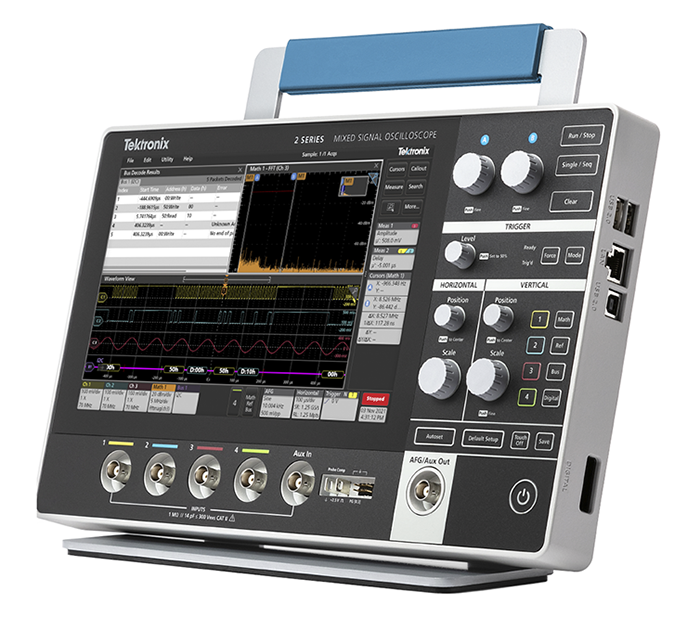
Compact, versatile oscilloscope for daily debug
The 2 Series MSO features up to 4 analog channels, 500 MHz bandwidth, 2.5 GS/s sample rate, 16 channel MSO, 50 MHz AFG, 4-bit digital pattern generator, advanced triggers, and protocol decode, all in a compact form factor about 1.5” thick. The 2 Series MSO is the go-to oscilloscope for electronic debug and test, no matter where you work.
With a capacitive touchscreen and a highly intuitive user interface truly designed for touch, the 2 Series MSO is a member of the Tektronix family of award-winning next generation oscilloscopes. The shared user interface and the programmatic interface makes it easy to use any Tektronix next generation oscilloscope
The optional battery pack extends the instrument capabilities by enabling the same instrument that is used in the lab to also be used in the field.
A large catalog of compatible probes and well-rounded set of accessories make the 2 Series MSO the most capable and versatile instrument in its class and suitable for a variety of applications.
The 2 Series MSO-EDU is also available in a bundled version for educators. It includes the oscilloscope, serial trigger and decode, digital inputs, arbitrary function generator, and five year warranty.
Key performance specifications
Analog input channels
2 or 4 inputs
Bandwidth
70 MHz, 100 MHz, 200 MHz, 350 MHz, and 500 MHz
Sample rate
- 2.5 GS/s half channels
- 1.25 GS/s all channels
Waveform capture rate
>4,000,000 wfms/s
Record length
10 M points per channel
Vertical resolution
- 8 bits ADC
- Up to 16 bits in high-resolution mode
Standard trigger types
Edge, pulse width, runt, timeout, logic, setup & hold, rise/fall time, and parallel bus
Standard analysis
- Cursors: Waveform, V bars, H bars, and V&H bars
- Measurements: 37
- Plots: XY, limit mask
- Math: Basic waveform arithmetic, FFT, and advanced equation editor
- Search: Search on any trigger criteria
Serial trigger, decode and analysis
- I2C, SPI, RS-232/422/485/UART, CAN, CAN FD, CAN XL, LIN, Automotive Ethernet 10BASE-T1S, and SENT
- Optional for MSO22 and MSO24
- Standard for MSO22-EDU and MSO24-EDU
Digital input channels
- 16 inputs
- Optional for MSO22 and MSO24
- Standard for MSO22-EDU and MSO24-EDU
Arbitrary function generator
- 50 MHz waveform generation
- Waveform types: Arbitrary, sine, square, pulse, ramp, triangle, DC level, gaussian, lorentz, exponential rise/fall, sin(x)/x, random noise, haversine, and cardiac
- Optional for MSO22 and MSO24
- Standard for MSO22-EDU and MSO24-EDU
Digital pattern generator
- 4 bit
- User defined, manual, and toggle
- Optional for MSO22 and MSO24
- Standard for MSO22-EDU and MSO24-EDU
Display
- 10.1-inch TFT color
- WXGA (1280 x 800) resolution
- Capacitive (multi-touch) touchscreen
Connectivity
- USB 2.0 Device (one port)
- USB 2.0 Host (dual-port)
- LAN (10/100 MB/s Base-T Ethernet)
Battery pack
- Battery pack with two battery slots and hot-swap capability
- Typical usage eight hours with dual batteries
- Optional accessory
Remote control
Remotely view and control the oscilloscope over a network connection through remote Virtual Network Computing (VNC).
VESA mount
100 mm x 100 mm VESA interface
Security
- Kensington lock, T-Bar style
- Software: Security options for connectivity
Standard probes
- One TPP0200 200 MHz, 10:1 voltage probe per channel
- One P6316 logic probe (MSO22-EDU and MSO24-EDU only)
Collaborative tools (optional)
- TekDrive: Save and recall waveforms, setups, and screenshots from TekDrive cloud. Share data with other members on the team.
- TekScope: Perform basic instrument control and transfer waveform data to PC. Offline analysis such as protocol decode, automated measurements, etc on saved data.
Optional Accessories
- Protective case bundle: Carrying bag, kick stand, protective rubber case
- Rackmount kit
- Hard case
- Battery charger
Warranty
- MSO22 and MSO24; one year standard
- MSO22-EDU and MSO24-EDU; five year total protection
Awards

Tektronix Next Generation Oscilloscopes

| 2 Series MSO | 3 Series MDO | 4 Series B MSO | 5 Series B MSO | 6 Series B MSO |
|---|---|---|---|---|
| Compact, portable, battery-operated instrument | Extreme versatility for any bench | Up to 6 channels of high-visibility bench test | Advanced analysis and up to 8 inputs | Unmatched detail on high-speed signals |
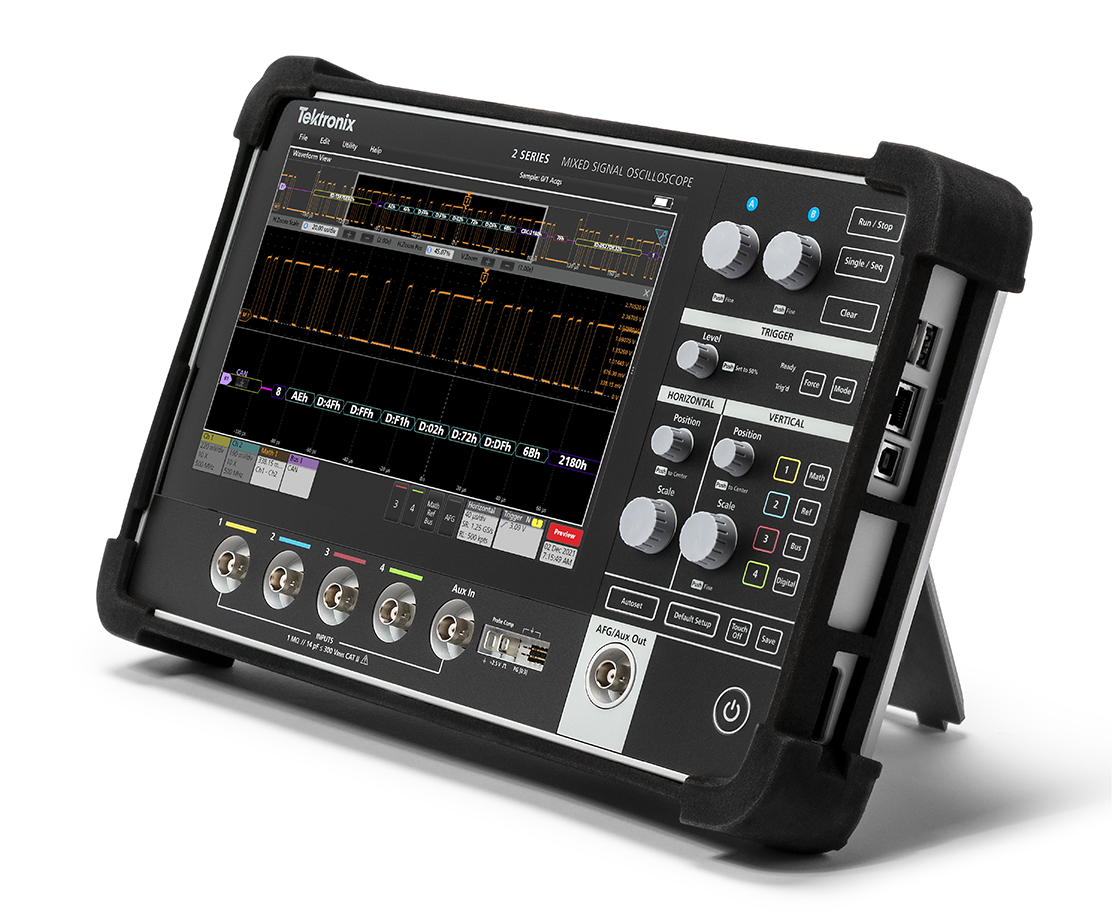
Intuitive touchscreen with simplified front panel
The 2 Series MSO offers the same, award-winning user interface as the higher end Tektronix oscilloscopes and supports the touch interactions that you have come to expect in a touch-enabled consumer device.
- Drag waveforms left/right or up/down to adjust horizontal and vertical position or to pan a zoomed view
- Pinch and expand to change scale or zoom in/out in either horizontal or vertical directions
- Swipe in from the right to reveal the results bar or down from the top to access the menus in the upper left corner of the display

The simplified front panel retains critical buttons and knobs with color-coded LED ring lights allowing quick access and easy adjustment of the most frequently-used instrument settings.
The membrane switch technology makes it rugged and suitable for use in harsh environments and easy to clean.
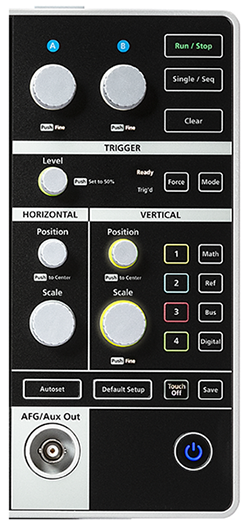
The combination of a streamlined front panel with an intuitive touch interface makes it easy for any new engineer to self-discover and begin using the instrument.
A USB mouse and a keyboard is also supported and can be used as a third interaction method with the instrument.

Exceptionally easy to use interface with comprehensive analysis for fast insight
The user interface on the 2 Series MSO is designed from the ground up for touch operation. All the key information is presented as a series of badges with visual cues to show association. Get immediate access to instrument configuration or waveform management tasks with a single tap.
The 2 Series MSO offers a revolutionary new stacked display mode in this class. Traditionally all the waveforms were overlayed on a single graticule leading to unwanted tradeoffs.
- Vertical scale and position of each waveform needs to be adjusted so that they do not overlap, resulting in usage of only a small percentage of the ADC range leading to inaccurate measurements.
Adjusting the waveform vertical scale and position leads to overlap, making it difficult to distinguish details on an individual waveform.
In the stacked display mode, each waveform gets its own slice (additional graticule) representing the full ADC range to enable maximum visibility and accuracy. Groups of channels can also be overlayed to enable visual comparison of signals.
The 2 Series MSO offers a comprehensive set of standard analysis tools including:
- Waveform and screen-based cursors with user-selectable readout location.
- 37 automated measurements with measurement statistics and gating, the ability to add an unlimited number of measurements, navigate from one occurrence to the next, and immediate viewing of the minimum or maximum result.
- Basic and advanced waveform math including arbitrary equation editing.
- Basic FFT analysis with options to view magnitude or phase, multiple options to customize window type, gating, and units. Works simultaneously across all analog channels.
The large display in the 2 Series MSO provides plenty of viewing area not only for signals, but also for plots, measurement results tables, bus decode tables, and more. You can easily resize and relocate the various views to suit your needs.
Triggering
Discovering a device fault is only the first step. Next, you must capture the event of interest to identify root cause. The 2 Series MSO provides a complete set of advanced triggers, including runt, logic, pulse width, triggers, timeout, rise/fall time, setup and hold, serial packet, and parallel data that can be used to capture complex infrequent events.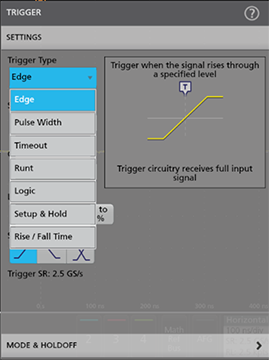
Act on event
Act on event capability built into the instrument enables users to setup the oscilloscope to respond by performing certain actions when a specified condition such as trigger event, measurement limit failure, search event or mask test events occur. This enables easy capture and analysis of rarely occurring events.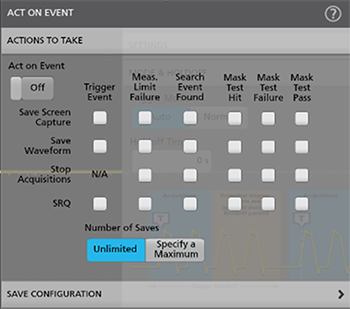
Navigation and search
With up to 10 M point record length, you can capture many events of interest, even thousands of serial packets in a single acquisition, while maintaining high resolution to zoom in on fine signal details.
Finding events of interest in a long waveform record can be time consuming without the right search tools.
The search feature allows you to automatically search through your acquisition for user-defined events. All occurrences of the event are highlighted with search marks for easy navigation. Search types include edge, pulse width, timeout, runt, window, logic, setup and hold, rise/fall time, and parallel/serial bus packet content. You can also quickly jump to the minimum and maximum value of search results.
Callouts
Documenting test results and methods are critical when sharing data across a team, recreating a measurement later or delivering a customer report.
With a few taps on the screen, you can create as many custom callouts as needed, enabling you to document the specific details on the waveforms. With each callout, you can customize the text, location, color, font size, and font. 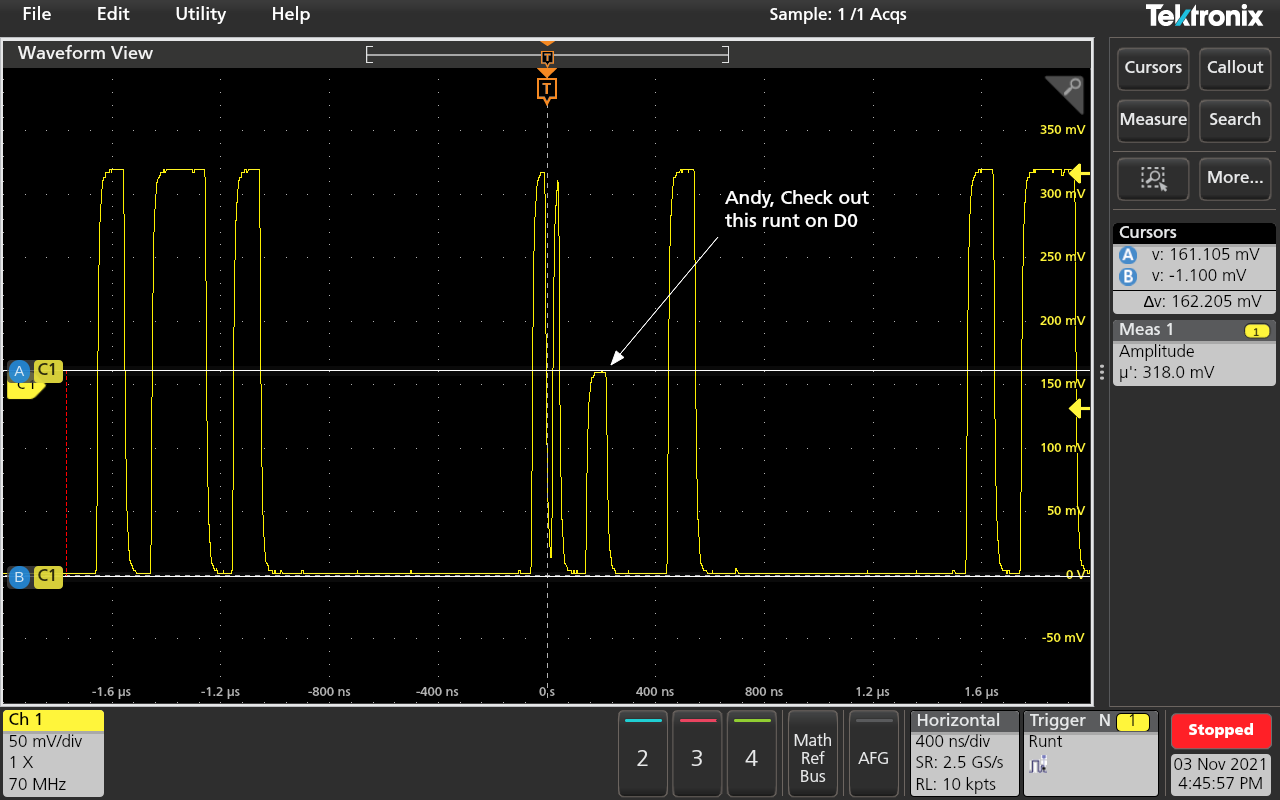
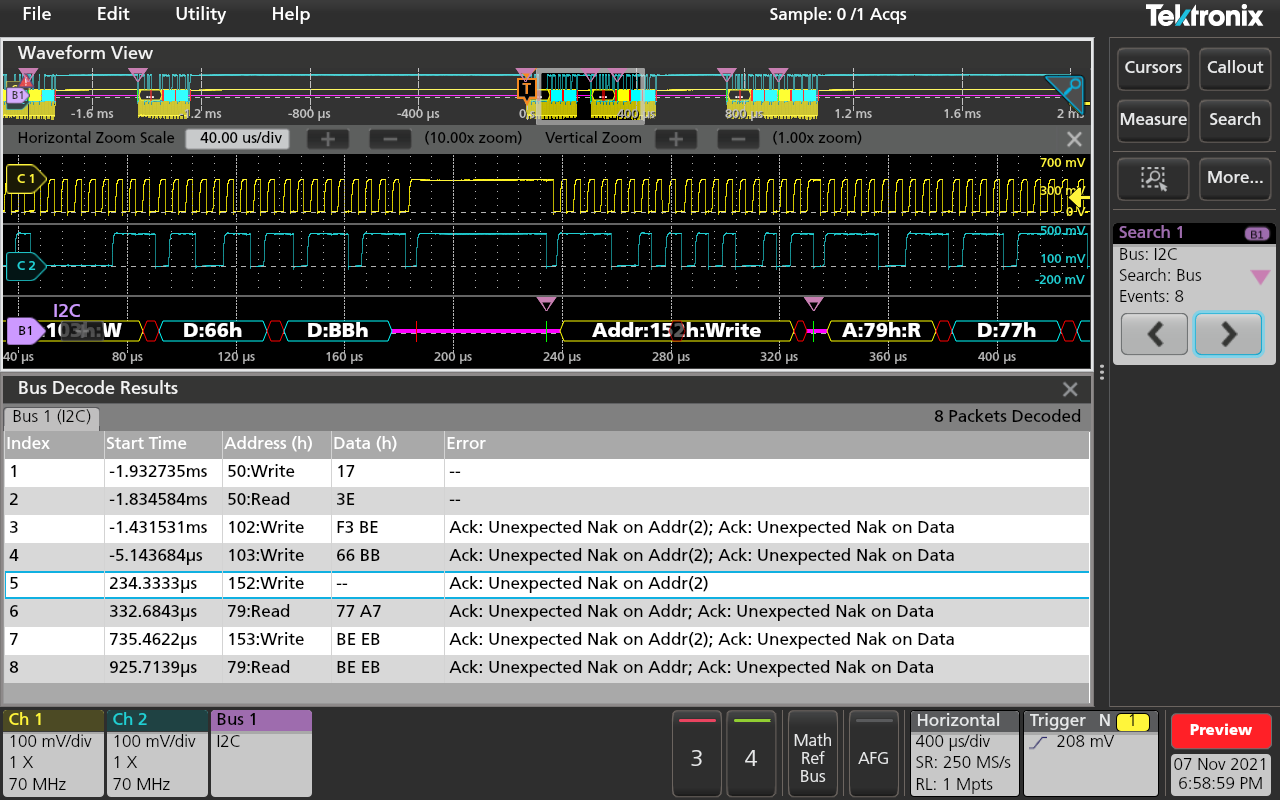
Mask testing
Mask testing offers a good way to test the quality of a signal. A mask defines a portion of the oscilloscope display that a signal must not enter. A mask can be defined either based on a golden signal with user defined tolerances or drawing mask segments on the screen.
The 2 Series MSO provides a comprehensive set of mask tools that allow:
- Defining test duration in number of waveforms
- Setting a violation threshold that must be met before considering a test failure
- Counting violations/failures and reporting statistical information
- Setting actions upon violations, test failure, and test complete
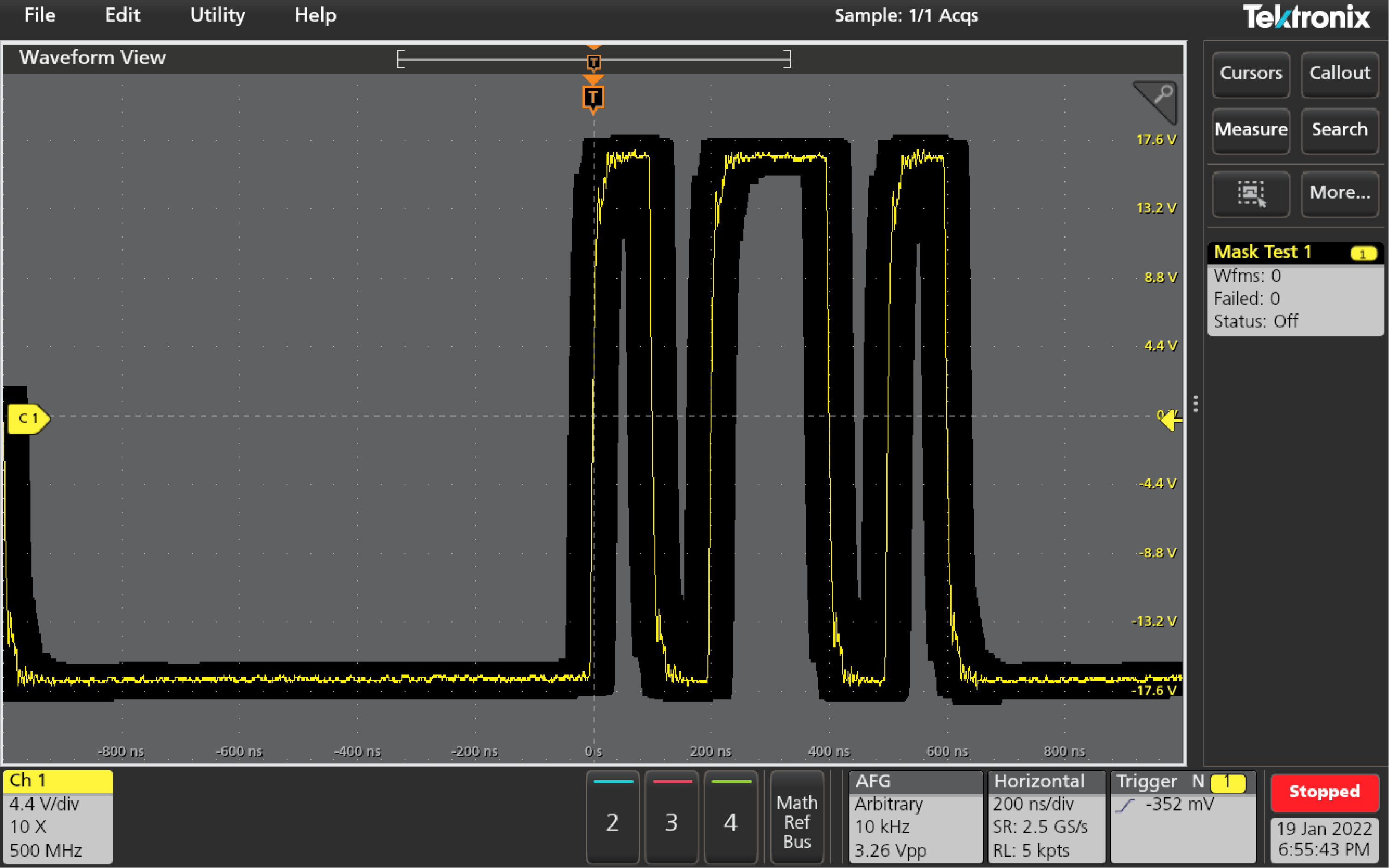
Serial protocol triggering and analysis
Serial protocol triggering and analysis is optional for the MSO22 and MSO24 and comes standard with the MSO22-EDU and MSO24-EDU.The 2 Series MSO offers a robust set of tools for working with the most common serial buses found in embedded design including I2C, SPI, RS-232/422/485/UART, CAN, CAN FD, CAN XL, LIN, Automotive Ethernet 10BASE-T1S, and SENT.
The protocol decode and triggering capability is invaluable to trace the flow of activity through a system by observing the traffic on one or more serial buses.
- Serial protocol triggering lets you trigger on specific packet content including start of packet, specific addresses, specific data content, unique identifiers, and errors.
- Bus waveforms provide a higher-level, combined view of the individual signals of your bus such as; clock, data, and chip enable. This makes it easy to identify where packets begin and end, and identifying sub-packet components such as; address, data, identifier, and CRC.
- The bus waveform is time-aligned with all other displayed signals, making it easy to measure timing relationships across various parts of the system under test.
- The bus decode table provides a tabular view of all decoded packets in an acquisition. Packets are timestamped and listed consecutively with columns for each component like address and data.
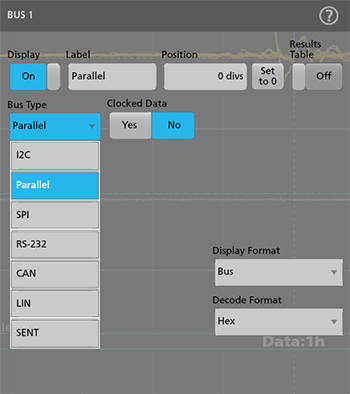
Digital channels
Digital channels are optional for the MSO22 and MSO24 and come standard with the MSO22-EDU and MSO24-EDU.A P6316 digital probe can be used to connect up to 16 signals to the digital inputs of the oscilloscope. The accessories that are included with the probe enable you to connect directly to 8x2 square pin headers. The included flying lead sets and grabbers can be used to clip into surface mount devices or test points offering additional flexibility.
Each digital channel can be viewed separately to see its state. Alternately, several digital channels can be grouped to view them in a bus form. Symbol tables can also be applied to the bus view to get a higher level view of the bus transactions. Pattern triggering capability can be used to trigger on a pattern of interest.
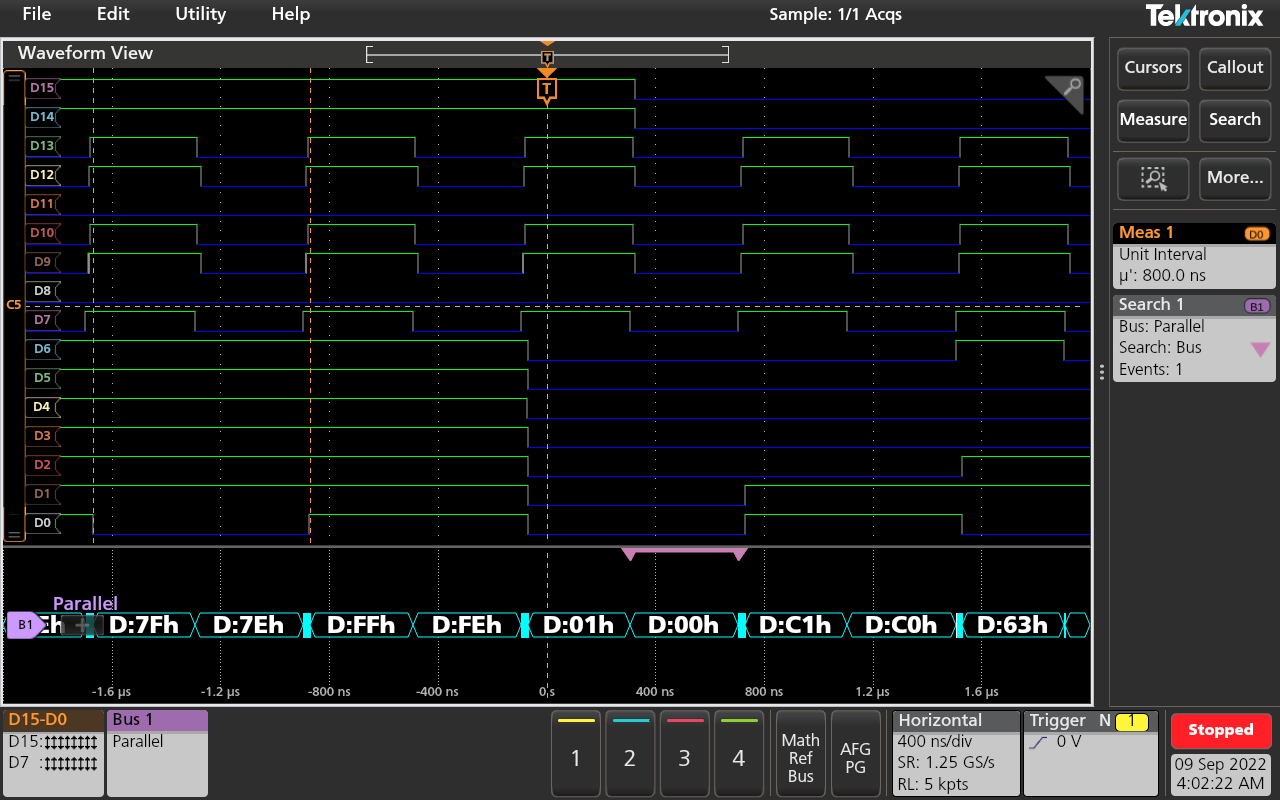
Experience the performance difference
Digital Phosphor technology with FastAcq™ high-speed waveform capture
To debug a design problem, first you must know it exists. Digital phosphor technology with FastAcq provides you with fast insight into the real operation of your device. Its fast waveform capture rate - greater than 4,000,000 waveforms per second - gives you a high probability of seeing the infrequent problems common in digital systems: runt pulses, glitches, timing issues, and more. To further enhance the visibility of rarely occurring events, intensity grading indicates how often rare transients are occurring relative to normal signal characteristics.
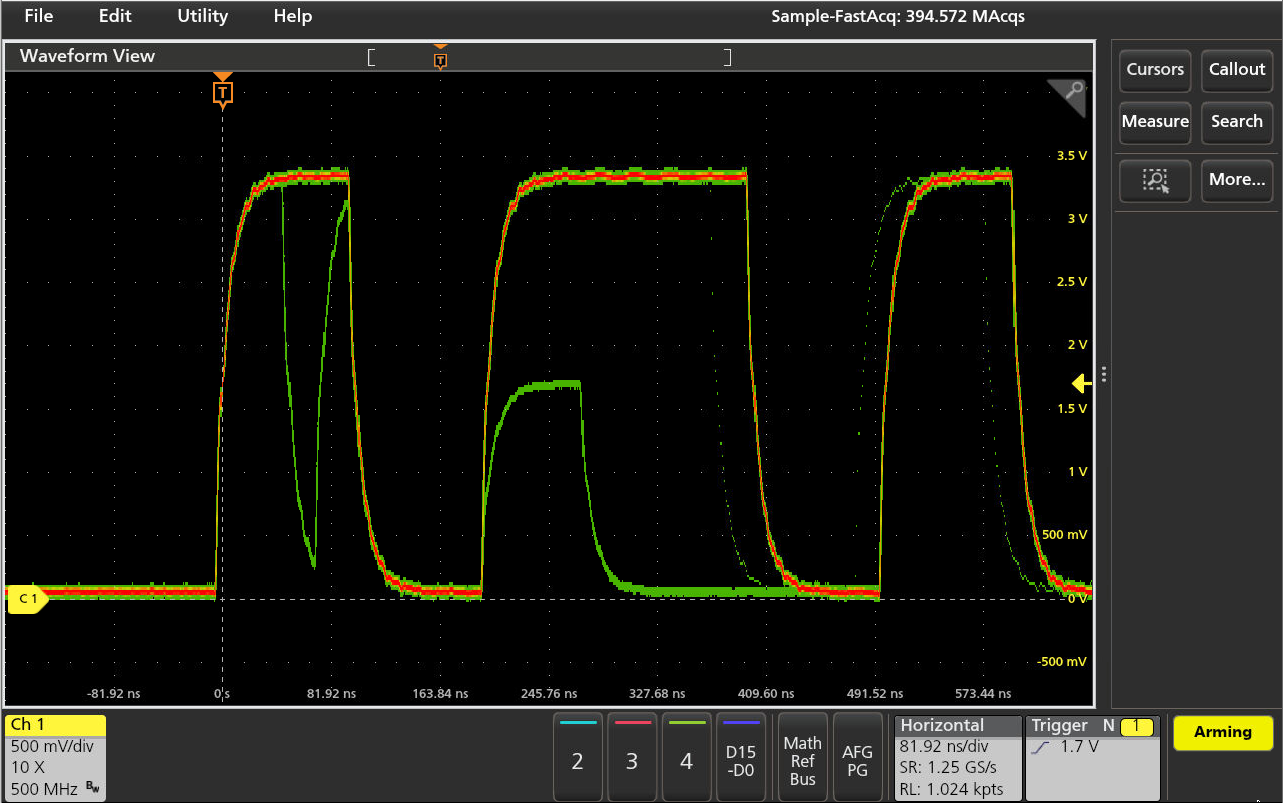
Arbitrary function generator (optional)
Arbitrary function generator is optional for the MSO22 and MSO24 and comes standard with the MSO22-EDU and MSO24-EDU.The 2 Series MSO includes an optional 50 MHz arbitrary function generator for simulating sensor signals within a design or adding noise to signals to perform margin testing. The AFG output is multiplexed with the Aux out signal.
Several predefined waveforms including sine, square, pulse, ramp/triangle, DC, noise, sin(x)/x (Sinc), gaussian, lorentz, exponential rise/fall, Haversine, and cardiac are included.
The arbitrary waveform generator provides 128k points of record for loading waveforms captured on the analog input, a saved file. Alternatively Tektronix ArbExpress PC-based waveform creation and editing software can be used to create complex waveforms quickly and easily.
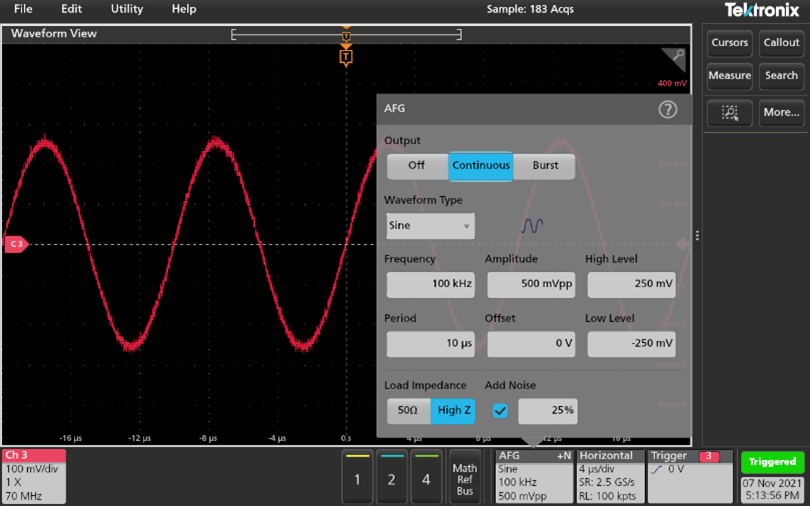
Bode plot
Bode plot is optional for the MSO22 and MSO24 and comes standard with the MSO22-EDU and MSO24-EDU.Analyze the frequency response of a system using the built-in Bode plot feature. The input voltage is swept across the user-selected range using the internal AFG or a supported external AFG. The gain and phase of the output relative to the input voltage is plotted at each point.
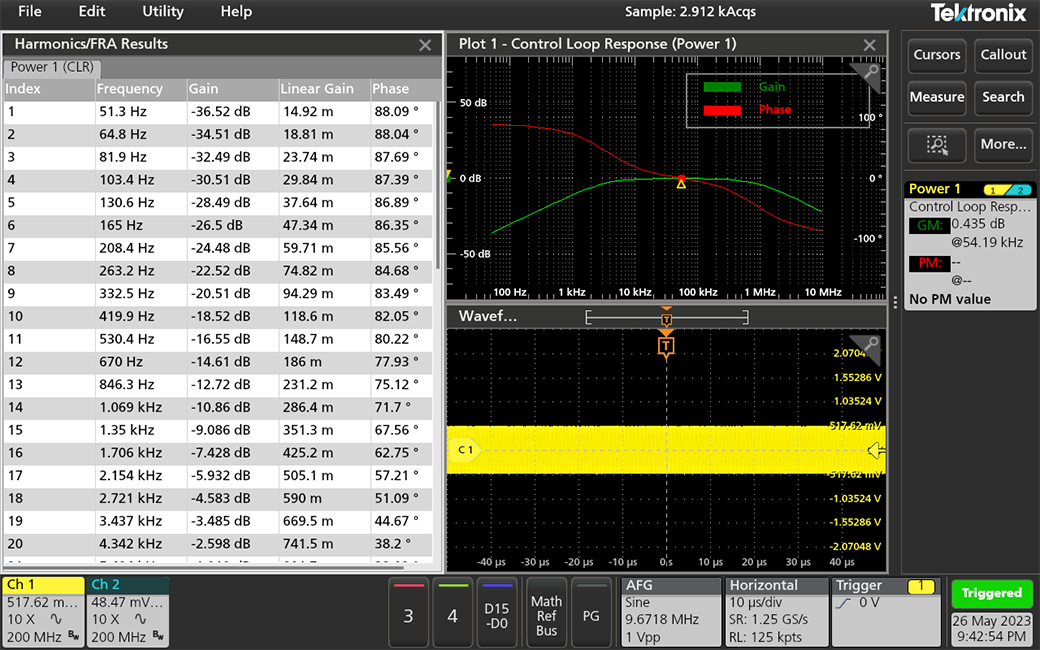
Digital pattern generator
Digital pattern generator is optional for the MSO22 and MSO24 and comes standard with the MSO22-EDU and MSO24-EDU.A 4-bit digital pattern generator with 4k point record length per bit is included on the 2 Series MSO for generating 4 digital signals at predefined voltage levels.
An output pattern can be loaded in memory using a predefined CSV file or the state of each output can be manually set to high, low, toggle, or Hi-Z as needed.

Connectivity
The 2 Series MSO contains several ports that you can use to connect the instrument to a network, directly to a PC, or to other test equipment.
- Two USB 2.0 ports enable easy transfer of screenshots, instrument settings, and waveform data to a USB mass storage device. A USB mouse and keyboard can also be attached to USB host ports for instrument control and data entry.
- The USB device port allows you to control the oscilloscope remotely from a PC.
- The standard 10/100BASE-T ethernet port enables easy connection to networks, and remotely controlling the instrument and viewing the acquired data.
Programmatic interface and backward compatibility
Programmable interface commands can be used to remotely control the instrument through the USB device port or the ethernet port. This enables programming the instrument to perform an automated set of tasks or integrating into a larger system that includes other equipment for performing specific tasks.
The programmatic interface command set is compatible with the next generation of Tektronix oscilloscopes making it easy to reuse code written for other Tektronix oscilloscopes.
The instrument also supports a compatibility mode that, when enabled, makes the 2 Series MSO compatible with the programmatic commands of the legacy TDS2000, TBS1000, and MSO/DPO2000 family of Tektronix oscilloscopes. This compatibility mode makes it easy to replace an older model oscilloscope in an existing test system with the 2 Series MSO.
Enhanced security
Hardware security includes a Kensington lock (T-Bar style) to prevent theft of the oscilloscope.
The 2 Series MSO provides you with the option to protect company data through the Security menu. This includes the option to restrict access to the instrument by password-protecting remote network access, I/O ports, and firmware updates to ensure the security of the data. By default, the oscilloscope disables remote access on initial use and gives you the option to enable remote access with or without a password.
To clear user data, run TekSecure from the menu.
Battery pack (optional)
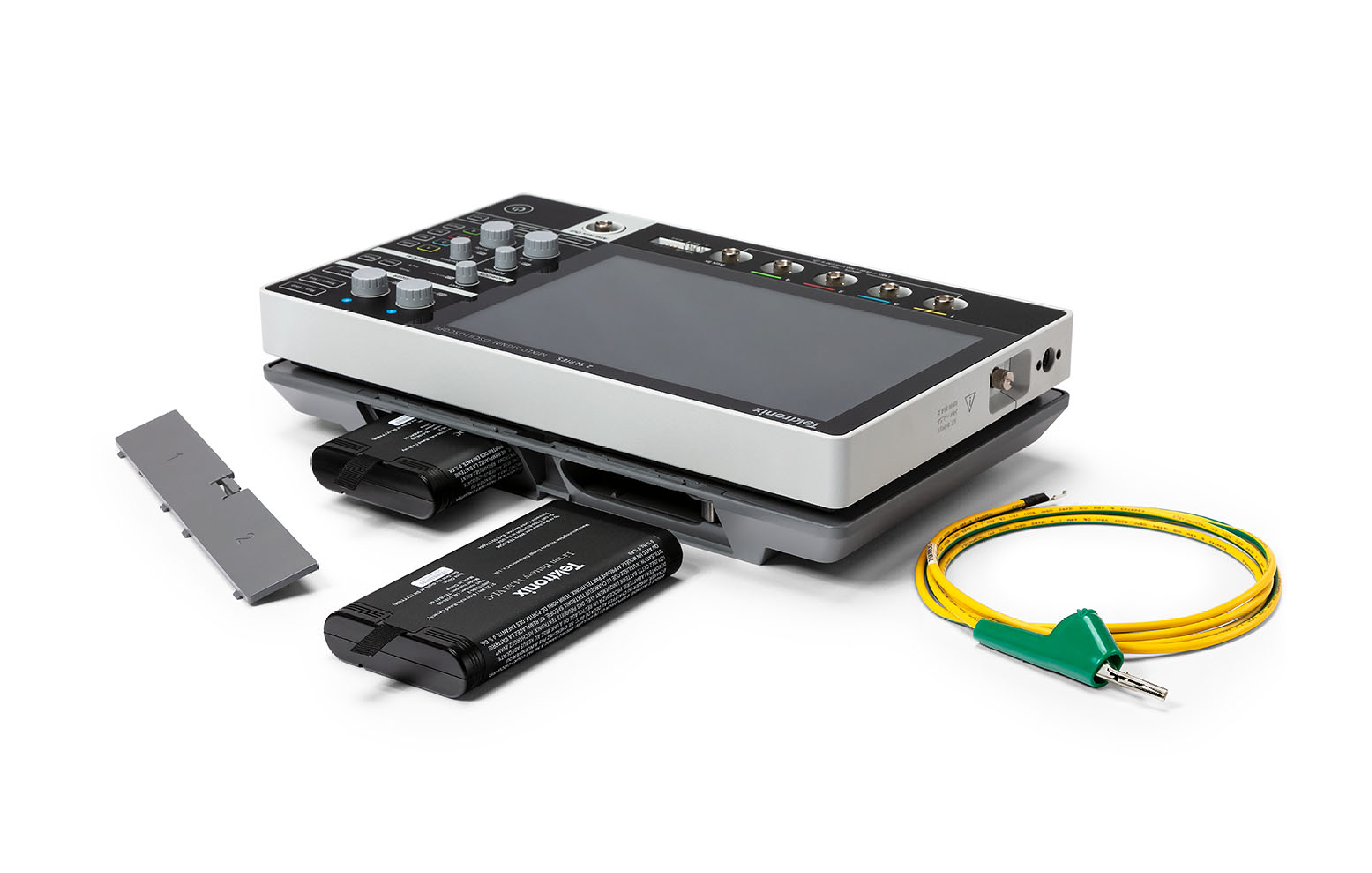
The 2 Series MSO also supports an optional battery pack that provides additional flexibility to perform measurements in areas where there is no AC power available such as testing equipment in the field.
The battery pack has two battery slots and can support hot swapping of the batteries during operation to extend run time on batteries.
The batteries are charged when the instrument is on AC power, or using an external charger.
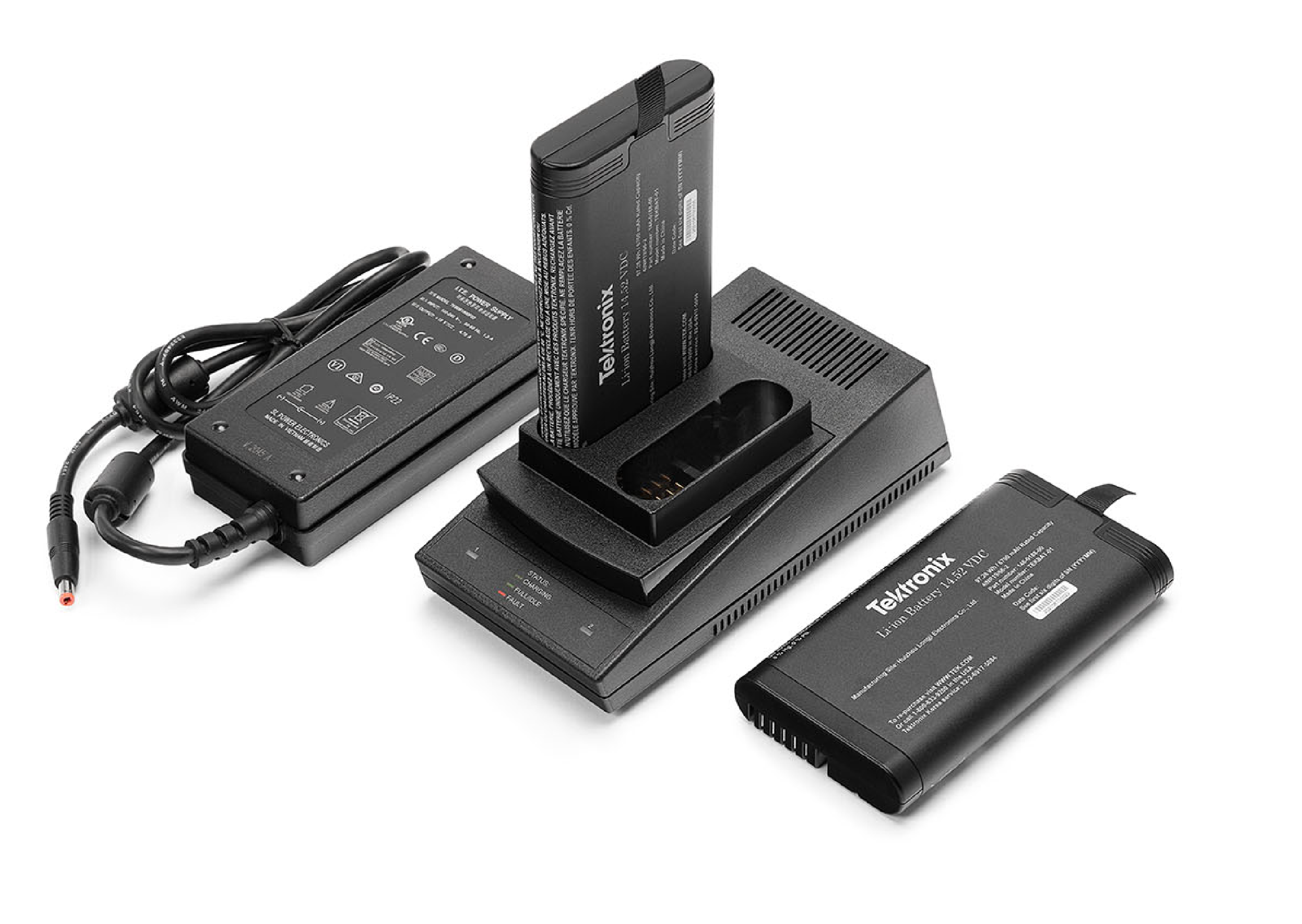
Accessories
In addition to the battery pack, several other accessories are available for the 2 Series MSO:
- Install the instrument in a rack for production with the rackmount kit.
- Carry the instrument into the field using the protective case bundle. The bundle includes a carrying bag, protective rubber case, and kick stand.
- Ship the instrument using the hard travel case.
The 100 mm x 100 mm standard VESA interface on the back of the instrument is compatible with a wide variety of accessories.
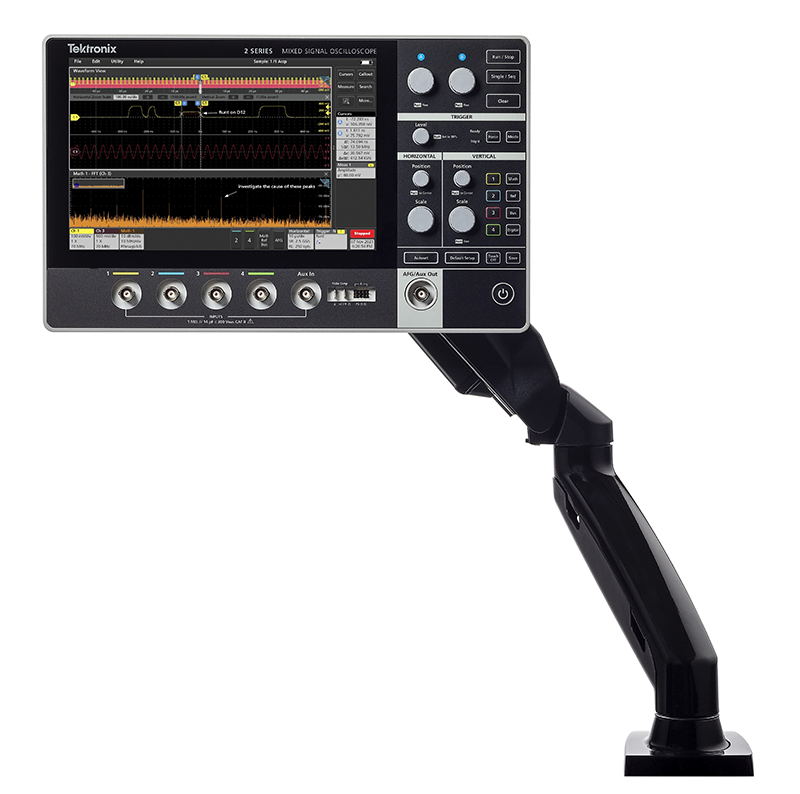
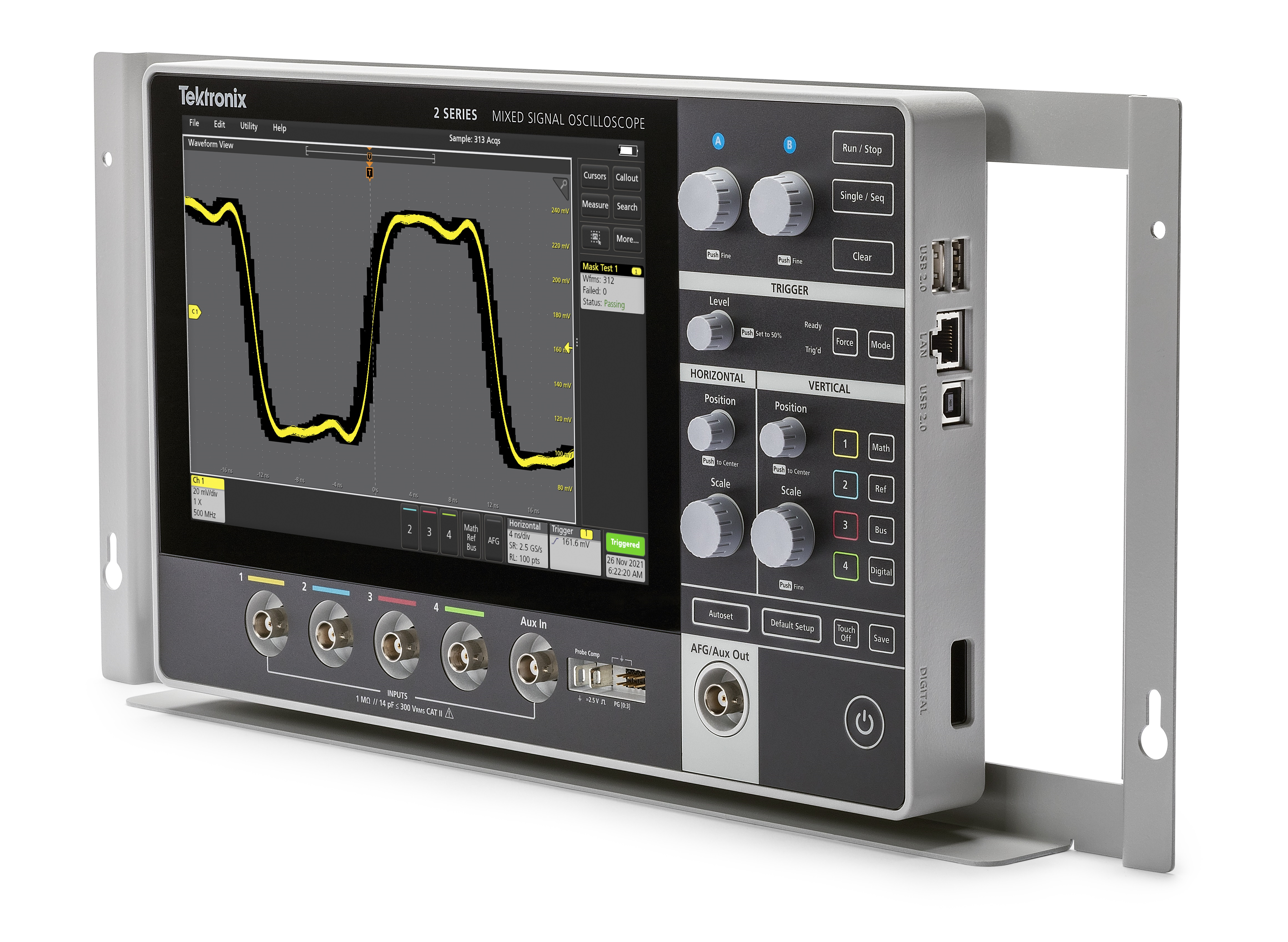
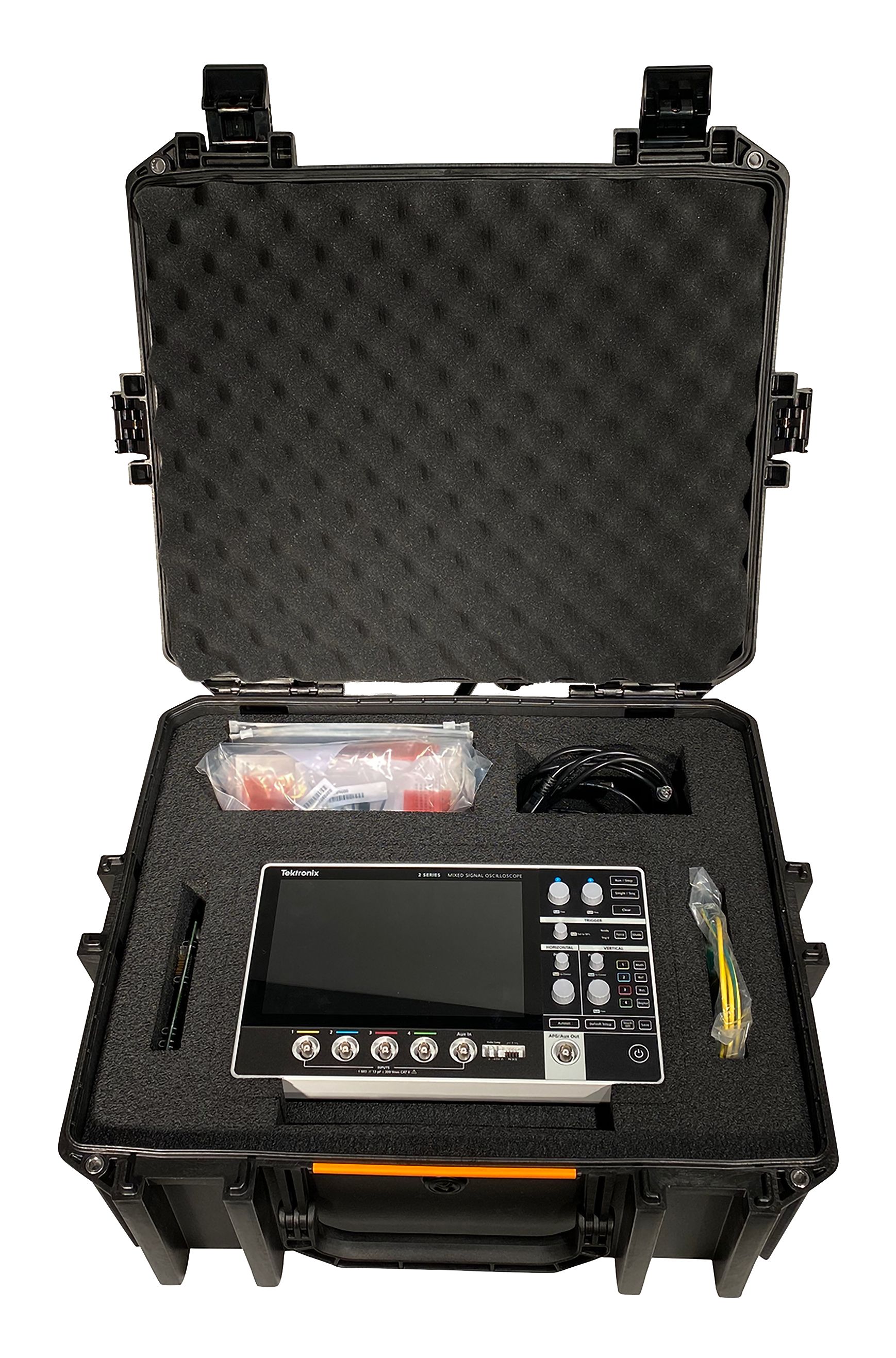
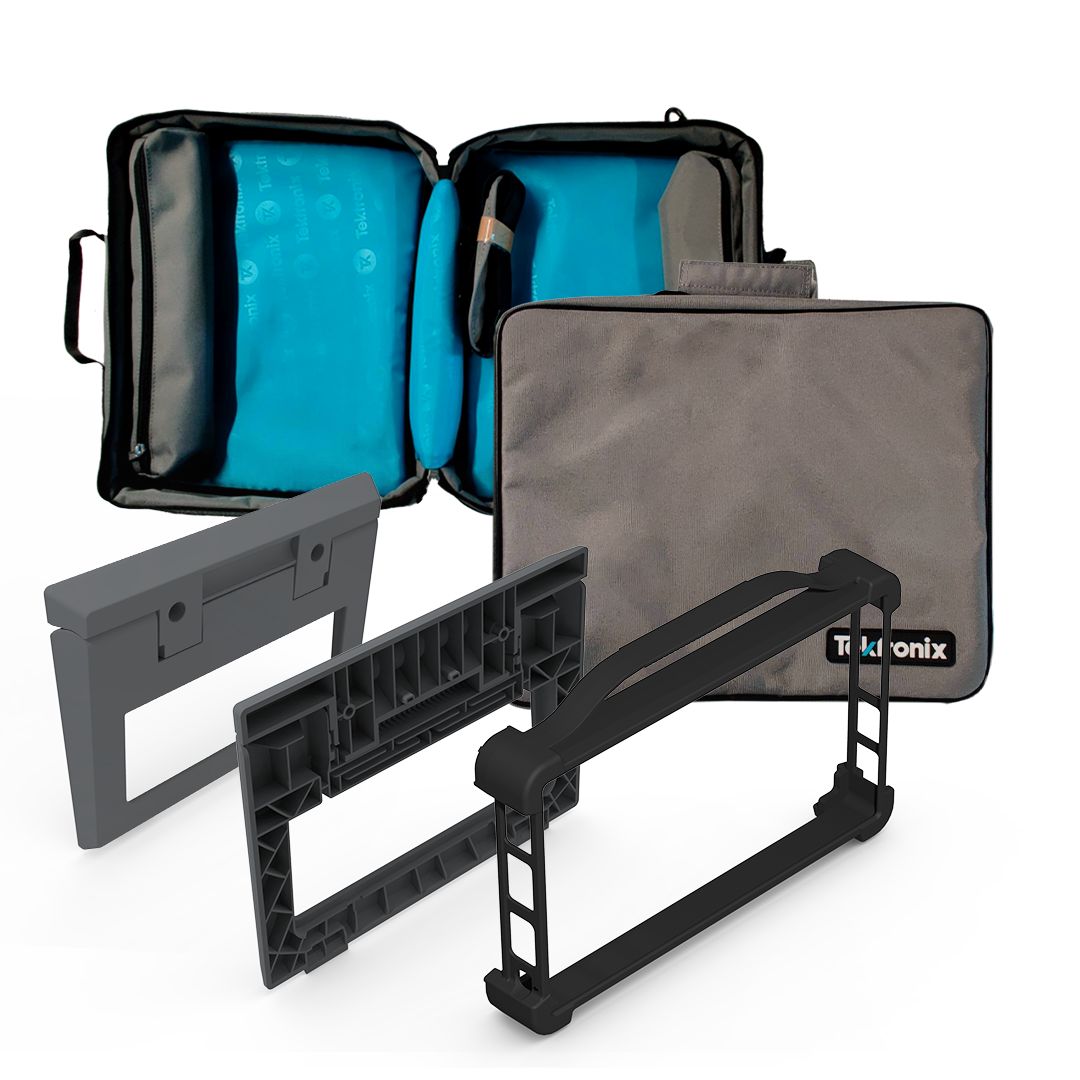
TekDrive
The 2 Series MSO is natively integrated with TekDrive collaborative test and measurement data workspace that allows users to upload, store, organize, search, download, and share any file type from any connected device.
- Seamlessly access your data anywhere
- Save/recall directly on instruments
- Inspect, analyze, and report saved data on any device using a browser
- Collaborate seamless with other contributors
- Integrate into any workflow with scripting using REST API
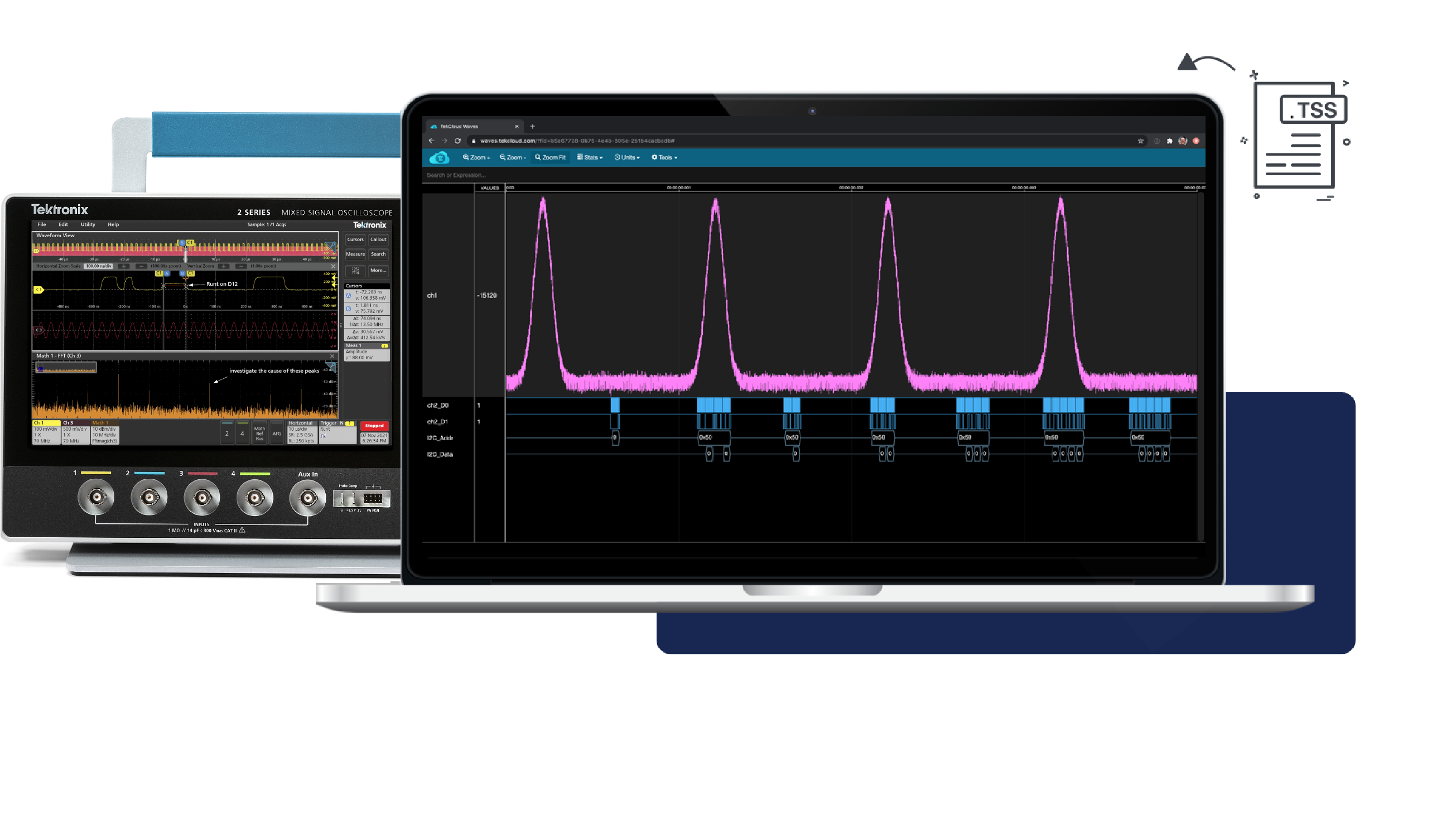
TekScope PC analysis software
Get the analysis capability of an award-winning oscilloscope on your PC. Analyze waveforms anywhere, anytime.- Analyze waveforms anywhere without an oscilloscope using the same UI as the oscilloscope
- Share data with colleagues and customers
- Synchronize waveforms from multiple oscilloscopes on the same screen
- Add advanced analysis capabilities such as spectrum analysis, jitter analysis, and advanced bus decoding
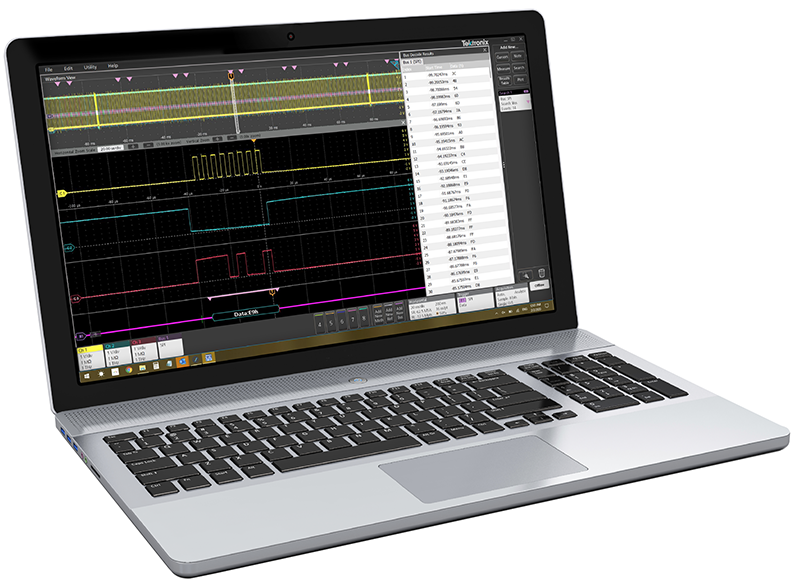
Kickstart
The 2 Series MSO is compatible with Kickstart Software. Kickstart is a PC-based application that enables setup and data collection across many types of bench instruments. It also offers a set of tools for quick and easy interaction and analysis of data.- Connect and control up to 8 instruments simultaneously
- Supports SMU, DMM, power supplies, oscilloscopes, AFG, data loggers, and sensitive instruments
- Automate data collection
- Save and replicate test configurations
- Plot collected data for a visual inspection of trends
- Export data in different formats
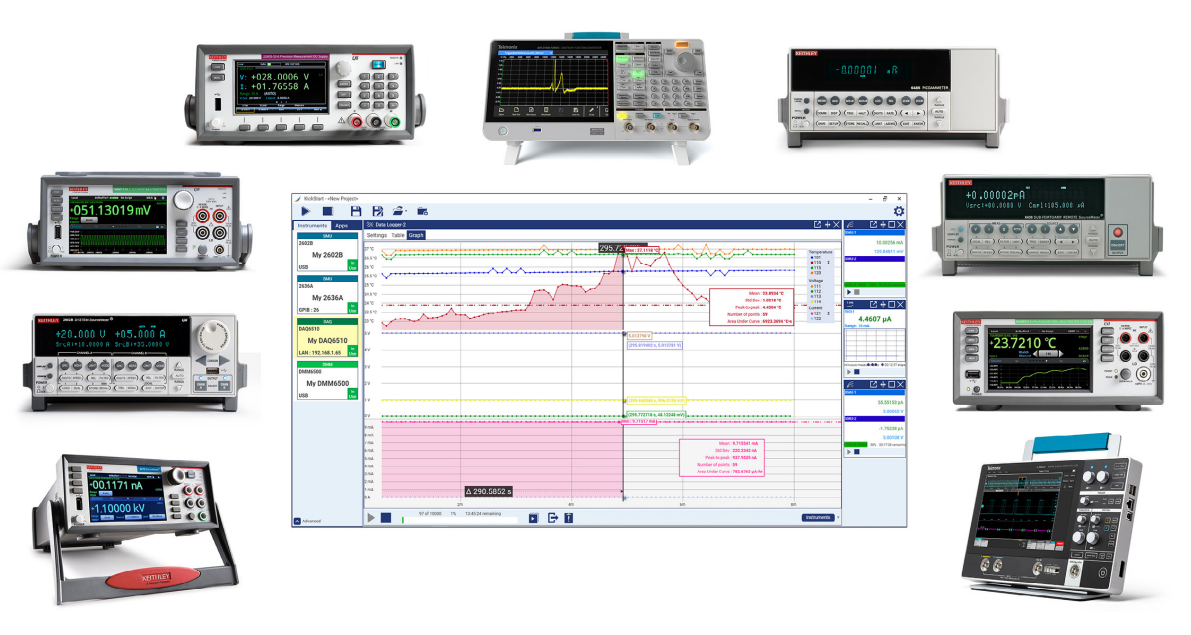
Education features
Help when you need it where you need it
The 2 Series MSO includes several helpful resources to get your questions answered rapidly without having to find a manual or go to a website:
- Graphical images and explanatory text are used in numerous menus to provide quick feature overviews.
- All menus include a question mark icon in the upper right that takes you directly to the portion of the integrated help system that applies to that menu.
- The Getting acquainted with your instrument section in the Help menu enables you to quickly come up to speed with the instrument in a few minutes.
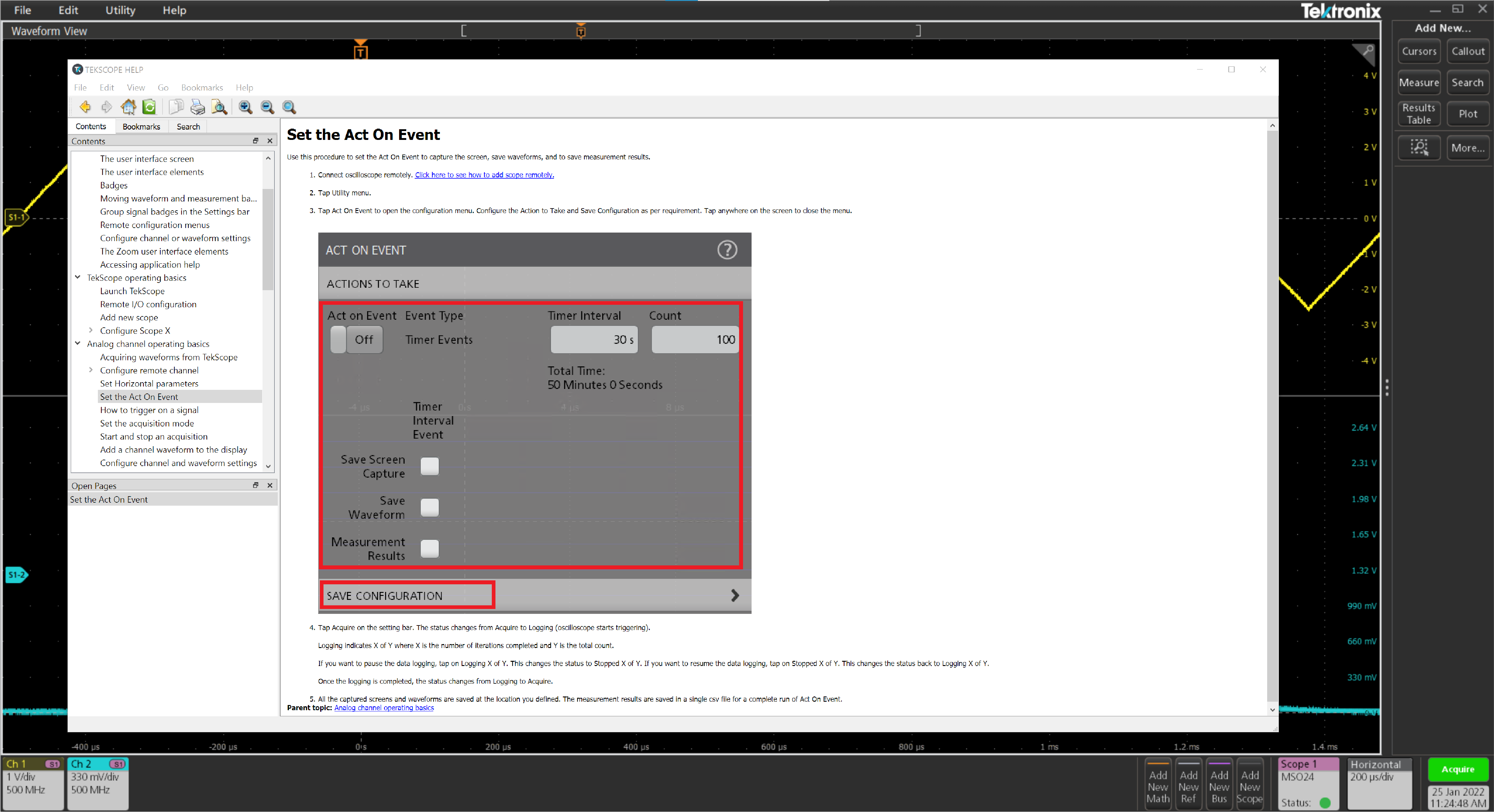
Feature control
The 2 Series MSO offers new ways to enable educators to devote more time to teaching circuit concepts instead of lab setup and management.
Educators can disable autoset, cursors, and automated measurements on the instruments. This allows students to focus on the basic concepts and helps them understand how to use the horizontal and vertical controls to get the waveform display, use the graticule to measure time and voltage, and manually plot/calculate the signal characteristics.
Get it all for one low price
The 2 Series MSO-EDU is available in a bundled version for educators. It includes the oscilloscope with all its valuable base features and all the extras: serial trigger and decode, digital inputs, arbitrary function generator, and a five year warranty. Available in two and four channel models and 70 MHz, 100 MHz, and 200 MHz bandwidths.
Specifications
All specifications are typical unless noted otherwise. All specifications apply to all models unless noted otherwise.
Model overview
| Specification | MSO22 | MSO24 | MSO22-EDU | MSO24-EDU |
|---|---|---|---|---|
| Analog channels | 2 | 4 | 2 | 4 |
| Analog channel bandwidth | 70 MHz, 100 MHz, 200 MHz, 350 MHz, and 500 MHz | 70 MHz, 100 MHz, and 200 MHz | ||
| 500 MHz bandwidth guaranteed from 4 mV/div to 10 V/div. | ||||
| Sample rate | 1.25 GS/s All channel, 2.5 GS/s half channels Interleaved | |||
| Record length | 10 M | |||
| Waveform Capture Rate, typical | >4,000,000 wfms/s | |||
| Digital channels | 16 | |||
| AFG outputs | 1 (multiplexed with Aux Out) | |||
Processor system
- Operating system
- Closed Linux
- Internal storage
- 100 MB of usable eMMC space
Vertical system analog channels
- Bandwidth limits
- (limited by instrument bw)
- 20 MHz, 70 MHz, 100 MHz, 200 MHz, 350 MHz, and 500 MHz
- Input coupling
- AC, DC
Input impedance
- BNC
- 1 MΩ ± 1%, 14 pF ± 3 pF
- TPP0200 probe tip
- 10 MΩ, < 12 pF
- P6139B probe tip
- 10 MΩ, < 8 pF
- Input sensitivity range
- 1 mV/div to 10 V/div
- Vertical resolution
- 8 Bit
- Maximum input voltage
- 300 Vrms CAT II with peaks < ±425 V
- Derate at 20 dB/decade between 3 MHz to 30 MHz
- Derate at 15.5 dB between 30 MHz to 300 MHz; above 300 MHz, 5 Vrms
- DC gain accuracy
- ±3% derated at 0.10%/°C above 30 °C
- Guaranteed, specification valid after 30 minute warm-up and Signal Path Compensation (SPC) at ambient.
- Crosstalk
- 100:1 <= 100 MHz, 30:1 > 100 MHz
- Offset range
- 1 mV/div to 63.8 mV/div : +/-1 V
- 63.9 mV/div to 999.5 mV/div : +/-10 V
- 1 V/div to 10 V/div : +/-100 V
Vertical system digital channels
- Input Channels
- 16 [D0:D15]
- Thresholds
- Thresholds per set of 8 channels
- Threshold Selections
- TTL, CMOS, ECL, PECL, User-Defined
- User Defined Range
- -15 V to +25 V
- Minimum detectable pulse
- 5 ns
- Threshold Accuracy
- ±180 mV + 2 % of threshold setting
- Minimum Input Signal Swing
- 500 mVp-p
- Maximum Input Signal Swing
- +30 V, -20 V
- Input Impedance
- 100 kΩ || 8 pF
- Vertical Resolution
- 1 bit
Horizontal system analog channels
- Timebase range
- 2 ns/div to 1000 s/div (all channel)
- 1 ns/div to 1000 s/div (half channel)
- Timebase delay range
- -10 divisions to 5000s
- Channel to channel deskew range
- -95 ns to +95 ns
- Timebase accuracy
- ± 25 ppm over any ≥1 ms interval
- Guaranteed, specification valid after 30 minute warm-up and Signal Path Compensation (SPC) at ambient.
Trigger system
- Trigger modes
- Auto, normal, and single
- Trigger coupling
- DC, HF Reject (attenuates > 50 kHz), LF Reject (attenuates < 50 kHz), noise reject (reduces sensitivity)
- Trigger holdoff range
- 0 s to 10 s
- Trigger sensitivity
- Edge type, DC coupled
- Any analog input channel: the greater of 6 mV or 0.8 div
- Aux In: 500 mVpp to 250 MHz
Trigger level ranges
- Any input channel
- ±5 divisions from center of screen
- Aux In
- ±8 V
Trigger types
- Edge
- Positive, negative, or either slope on any channel.
- Pulse Width
- Trigger on width of positive or negative pulses. Event can be time- or logic-qualified.
- Timeout
- Trigger on an event which remains high, low, or either, for a specified time period. Event can be logic-qualified.
- Runt
- Trigger on a pulse that crosses one threshold but fails to cross a second threshold before crossing the first again. Event can be time- or logic-qualified.
- Logic
- Trigger when logic pattern goes true, goes false, or occurs coincident with a clock edge. Pattern (AND, OR, NAND, NOR) specified for all input channels defined as high, low, or don't care. Logic pattern going true can be time-qualified.
- Setup/Hold
- Trigger on violations of both setup time and hold time between clock and data present on any input channels.
- Rise/Fall
- Trigger on pulse edge rates that are faster or slower than specified. Slope may be positive, negative, or either. Event can be logic-qualified.
- Parallel (with MSO option)
- Trigger on a parallel bus data value. Parallel bus can be from 1 to 20 bits (from the digital and analog channels) in size. Supports binary and hex radices.
- I2C (option)
- Trigger on start, repeated start, stop, missing ack, address (7 or 10 bit), data, or address and data on I2C buses up to 10 Mb/s.
- SPI (option)
- Trigger on slave select, idle time, or data (1-16 words) on SPI buses up to 20 Mb/s.
- RS-232/422/485/UART (option)
- Trigger on start bit, end of packet, data, and parity error up to 15 Mb/s.
- CAN (option)
- Trigger on start of frame, type of frame (data, remote, error, or overload), identifier, data, identifier and data, end of frame, missing ack, and bit stuff error on CAN buses up to 1 Mb/s, on CAN FD buses up to 16 Mb/s and on CAN XL buses up to 20 Mb/s.
- LIN (option)
- Trigger on sync, identifier, data, identifier and data, wakeup frame, sleep frame, and error on lin buses up to 1 Mb/s.
- SENT (option)
- Trigger on start of packet, fast channel status and data, slow channel message ID and data, and CRC errors.
- Automotive Ethernet 10BASE-T1S (option)
- Trigger on Sync\Commit, Start of Stream Delimiter, Preamble, Beacon, End of Stream Delimiter, or Errors.
Acquisition system modes
- Sample
- Acquired sample values
- Peak Detect
- Highest and the lowest sample within the decimation interval
- Averaging
- Average of a series of acquired waveforms up to 10,240 acquisitions
- Envelope
- Min-Max envelope over multiple acquisitions
- FastAcq(tm)
- FastAcq optimizes the instrument for the analysis of dynamic signals and capture of infrequent events by capturing >4,000,000 wfms/s.
- Hi-Res
- Applies a unique bandwidth filter for each sample rate that maintains the maximum bandwidth possible for that sample rate while preventing aliasing and removing noise from the oscilloscope amplifiers and ADC above the usable bandwidth for the selected sample rate.
- Roll Mode
- Scrolls sequential waveform points across the display in a right-to-left rolling motion, at timebase speeds of 40 ms/div and slower, when in Auto trigger mode.
Waveform measurements
- Cursors
- Waveform, V bars, H bars, and V&H bars
- Automatic measurements
- 37, of which an unlimited number can be displayed as either individual measurement badges or collectively in a measurement results table
- Amplitude measurements
- Amplitude, maximum, minimum, peak-to-peak, positive overshoot, negative overshoot, mean, RMS, AC RMS, top, base, and area
- Time measurements
- Period, frequency, unit interval, data rate, positive pulse width, negative pulse width, skew, delay, rise time, fall time, phase, rising slew rate, falling slew rate, burst width, positive duty cycle, negative duty cycle, time outside level, setup time, hold time, duration n-periods, high time, and low time, time to max, and time to min
- Measurement statistics
- Mean, standard deviation, maximum, minimum, and population. Statistics are available on both the current acquisition and all acquisitions
- Reference levels
- User-definable reference levels for automatic measurements can be specified in either percent or units. Reference levels can be set to global for all measurements, per source channel or signal, or unique for each measurement
- Gating
- Screen, cursors, logic, search, or time. specifies the region of an acquisition in which to take measurements. Gating can be set to global (affects all measurements set to global) or local (all measurements can have a unique time gate setting; only one local gate is available for screen, cursors, logic, and search actions).
Waveform math
- Number of math waveforms
- Unlimited
- Arithmetic
- Add, subtract, multiply, and divide
- Math Functions
- Integrate, differentiate, log 10, log e, square root, exponential, and abs
- Relational
- Boolean result of comparison >, <, ≥, ≤, =, and ≠
- Logic
- AND, OR, NAND, NOR, XOR, and EQV
- FFT
- Spectral magnitude and phase, and real and imaginary spectra
- FFT units
- Magnitude: linear and log (dBm)
- Phase: degrees, radians, and group delay
- FFT window functions
- Hanning, rectangular, hamming, blackman-harris, flattop2, gaussian, kaiser-bessel, and tekexp
Search
- Search Types
- Search through long records to find all occurrences of user specified criteria including edges, pulse widths, timeouts, runt pulses, logic patterns, setup & hold violations, rise/fall times, and bus protocol events.
- Search results
- Waveform view, results table.
Arbitrary function generator
- Number of channels
- 1 (Multiplexed with Aux Out)
- Operating modes
- Continuous, burst
- Waveforms
- Sine, square, pulse, ramp, triangle, dc, noise, sin(x)/x(sinc), gaussian, lorentz, exponential rise, exponential decay, haversine, cardiac, and arbitrary
- Amplitude and frequency range
Signal type Amplitude range 50 Ω Amplitude range 1 MΩ Frequency range Sine 10 mV to 2.5 V 20 mV to 5 V 0.1 Hz to 50 MHz Square 10 mV to 2.5 V 20 mV to 5 V 0.1 Hz to 20 MHz Pulse 10 mV to 2.5 V 20 mV to 5 V 0.1 Hz to 20 MHz Ramp 10 mV to 2.5 V 20 mV to 5 V 0.1 Hz to 500 KHz DC Level 20 mV to 5V Gaussian 10 mV to 1.25 V 20 mV to 2.5 V 0.1 Hz to 5 MHz Lorentz 10 mV to 1.2 V 20 mV to 2.4 V 0.1 Hz to 5 MHz Haversine 10 mV to 1.25 V 20 mV to 2.5 V 0.1 Hz to 5 MHz Exponential 10 mV to 1.25 V 20 mV to 2.5 V 0.1 Hz to 5 MHz Sin(X)/X 10 mV to 1.5 V 20 mV to 3 V 0.1 Hz to 2 MHz Random noise 10 mV to 2.5 V 20 mV to 5 V Cardiac 10 mV to 2.5 V 20 mV to 5 V 0.1 Hz to 500 KHz Arbitrary 10 mV to 2.5 V 20 mV to 5 V 0.1 Hz to 25 MHz
DC offset
- DC offset range
- ±2.5 V into Hi-Z, ±1.25 V into 50 Ω
- DC offset resolution
- 1 mV into Hi-Z, 500 uV into 50 Ω
- DC offset accuracy
- ±[(1.5% of absolute offset voltage setting) + 1 mV]
- Guaranteed, specification valid after 30 minute warm-up and Signal Path Compensation (SPC) at ambient.
Digital pattern generator
- Number of channels
- 4
- Pattern memory length
- 4 K bits
- Output amplitude
- 2.5 V, 3.3 V, 5 V (Continuous Mode)
- 5 V ( Burst Mode)
- Bit Rate
- 1 bps to 25 Mbps
Display
- Display type
- 10.1 Inch LCD capacitive touch display
- Display resolution
- 1280 x 800
- Display modes
- Overlay
- Stacked
- Zoom
- Horizontal and vertical zooming is supported in all waveform and plot views.
- Interpolation
- Sin(x)/x and linear
- Waveform styles
- Vectors, dots, variable persistence, and infinite persistence
- Graticules
- Movable and fixed graticules, selectable between grid, time, full, and none
- Color palettes
- Normal and inverted for screen captures
- Individual waveform colors are user-selectable
- Format
- YT, XY
- Language support
- English, Japanese, Simplified Chinese, Traditional Chinese, French, German, Italian, Spanish, Portuguese, Russian, Korean
Input/Output ports
- USB interface
- Two USB 2.0 host ports
- One USB device port (providing USBTMC support)
- Ethernet interface
- One ethernet port, 10/100 Mb/s, and 1000 Mbps ethernet (in full duplex mode only)
Probe compensation signal
- Amplitude
- 0 to 2.5 V
- Frequency
- 1 kHz
- Source impedance
- 1 kΩ
- Aux out
- Front panel BNC connector multiplexed with AFG out. Output can be configured to provide a positive or negative pulse when oscilloscope triggers.
Characteristics Limits Vout (HI) ≥ 2.5 V open circuit; ≥ 1.0 V into a 50 Ω load to ground. Vout (LO) ≤ 0.7 V into a load of ≤ 4 mA; ≤ 0.25 V into a 50 Ω load to ground.
- Aux input
- 300 Vrms CAT II with peaks ≤ ±425 V.
- Security lock
- Rear-panel security slot connects to standard T-bar style Kensington-style lock.
- VESA mount
- Standard (VESA MIS-D 100) 100 mm x 100 mm VESA mounting points on rear of instrument.
- Ground lug
- Provides a safe ground return path when the instrument is operating on battery.
Software
- VNC
- Remotely control and view the screen on the instrument
- IVI Driver
- Provides a standard instrument programming interface for common applications such as LabVIEW, LabWindows/CVI, Microsoft .NET, and MATLAB. Compatible with python, C/C++/C# and many other languages through VISA.
- TekScope
- TekScope brings the power of the oscilloscope analysis environment to the PC. You can have the flexibility to perform analysis tasks including serial decode, power analysis, timing, eye, and jitter analysis outside the lab. Visit https://www.tek.com/software/tekscope-pc-analysis-software to learn more.
- TekDrive
- Upload, store, organize, search, download, and share any file type from any connected device. TekDrive is natively integrated into the 2 Series MSO for seamless sharing and recalling of files - no USB stick is required. Visit http://www.tek.com/software/tekdrive to learn more.
- Programming examples
- Programming with the 2/4/5/6 Series platforms has never been easier. With a programmers manual and a GitHub site you have many commands and examples to help you get started remotely automating your instrument. See https://github.com/TEKTRONIX/PROGRAMMATIC-CONTROL-EXAMPLES
Power
- Line power
- 100 - 240 V ± 10% at 50 Hz to 60 Hz
- AC Adapter output
- 24 V DC, 2.71 A
- Power consumption
- 60 W (max)
Battery
- Battery power
- Requires Opt 2-BATPK or 2-BP battery pack, with 2 slots for batteries
- Supports up to 2 TEKBAT-01 Li-Ion rechargeable batteries
- Cell chemistry
- Li-lon
- Nominal capacity
- 6700 mAh
- Voltage
- 14.52 VDC
- Weight
- 450 g/1lb
- Operating time, typical
- Up to 4 hours single battery
- Up to 8 hours dual batteries
- Hot swappable
Physical characteristics
Dimensions
Instrument only
- Height
- 210 mm (8.26 in)
- Width
- 344 mm (13.54 in)
- Depth
- 40.4 mm (1.59 in)
Instrument with battery pack
- Height
- 210 mm (8.26 in)
- Width
- 344 mm (13.54 in)
- Depth
- 78 mm (3.07 in)
Weight
- Instrument only
- 1.8 kg (4 lbs)
- Instrument with battery pack
- 3.2 kg (7 lbs) – one battery
- 3.6 kg (8 lbs) – two batteries
- Rackmount configuration
- 5U
- Clearance requirements
- The clearance requirement for adequate cooling is 13 mm (0.5 in) on the rear of the instrument along the bottom edge (inlet vents) and top edge (exhaust vents).
EMC, environmental, and safety
Temperature
- Operating
- 0 °C to +50 °C (+32 °F to 120 °F)
- Operating battery
- 0 °C to 45 °C (+32 °F to 113 °F)
- Non-operating
- -20 °C to +60 °C (-4 °F to 140 °F)
Humidity
- Operating
- 5% to 90% relative humidity at temperatures up to +30 °C,
- 5% to 60% relative humidity at temperatures greater than +30 °C and up to +50 °C.
- Non-operating
- 5% to 90% relative humidity at temperatures up to +30 °C,
- 5% to 60% relative humidity at temperatures greater than +30°C and up to +60 °C.
Altitude
- Operating
- Up to 3,000 meters (9,842 feet)
- Non-operating
- Up to 12,000 meters (39,370 feet)
Regulatory compliance
- EMC
- Conforms to European Union EMC Directive (CE-marked)
- Safety
- Conforms to European Union Low Voltage Directive (CE-marked)
- Conforms to ANSI/UL61010-1 and ANSI/UL61010-2-030 (CSA-marked)
- Certified to CAN/CSA C22.2 No.61010-1 and CAN/CSA C22.2 No.61010-2-030 (CSA-marked)
- RoHS
- Conforms to European Union Restrictions on Hazardous Substances (CE-marked)
Ordering information
Use the following steps to select the appropriate instrument and options for your measurement needs.
Step 1 – Select instrument model
Select the 2 Series MSO instrument model
| Model | Description |
|---|---|
| MSO22 | Mixed Signal Oscilloscope: 2 analog channels, 2.5 GS/s sample rate, 10 Mpts record length |
| MSO24 | Mixed Signal Oscilloscope: 4 analog channels, 2.5 GS/s sample rate, 10 Mpts record length |
| MSO22-EDU | Mixed Signal Oscilloscope: 2 analog channels, 16 digital channels, 2-ULTIMATE, 2-MSO, T5 |
| MSO24-EDU | Mixed Signal Oscilloscope: 4 analog channels, 16 digital channels, 2-ULTIMATE, 2-MSO, T5 |
| Each model includes |
|---|
|
Step 2 – Configure bandwidth (required)
Configure your oscilloscope by selecting the analog channel bandwidth you need. You can also upgrade the bandwidth later by purchasing an upgrade option.
| Bandwidth option | Bandwidth range |
|---|---|
| 2-BW-70 | 70 MHz |
| 2-BW-100 | 100 MHz |
| 2-BW-200 | 200 MHz |
| 2-BW-350 | 350 MHz (not available on MSO2X-EDU) |
| 2-BW-500 | 500 MHz (not available on MSO2X-EDU) |
Step 3 – Add functionality
Order additional items with your instrument.
| Option | Description |
|---|---|
| 2-P6139B | Add 500 MHz, 10x probes (one per channel). This is the recommended option for 350 MHz or 500 MHz bandwidth instruments. |
| 2-BATPK | Battery pack with 2 battery slots and 1 battery (ships with instrument) for use with the 2 Series MSO. |
Step 4 – Add instrument software functionality with an option bundle
Choose from option bundles with different levels of functionality to suit your application needs.
| Feature | Description |
|---|---|
| 2-MSO | Add MSO function with 16 digital channels; includes P6316 digital probe and accessories; included on MSO2X-EDU |
| 2-SOURCE | Arbitrary function generator (AFG), digital pattern generator (DPG), and frequency response analysis (Bode plot); included on MSO2X-EDU |
| 2-SERIAL | I2C, SPI, RS-232/422/485/UART, CAN, CAN FD, CAN XL, LIN, Automotive Ethernet 10BASE-T1S, and SENT serial trigger and analysis; included on MSO2X-EDU |
| 2-ULTIMATE | Includes 2-SOURCE and 2-SERIAL |
Step 5 – Add additional probes and adapters
Add additional recommended probes and adapters
| Passive voltage probes | Description |
|---|---|
| TPP0100 | 100 MHz bandwidth, 10x attenuation, BNC interface |
| TPP0200 | 200 MHz bandwidth, 10x attenuation, BNC interface |
| P2221 | 6 MHz to 200 MHz bandwidth, 1x / 10x attenuation, BNC interface |
| P6139B | 500 MHz bandwidth, 10x attenuation, BNC interface |
| P6101B | 15 MHz bandwidth, 1x attenuation, BNC interface |
| P3010 | 100 MHz bandwidth, 10x attenuation, BNC interface |
| Current probes | Description |
|---|---|
| TCPA300 | Current probe amplifier; 50 Ω feed-through termination (011-0049-XX) is required |
| With TCP312A | DC to 100 MHz, 1 mA |
| With TCP305A | DC to 50 MHz, 5 mA |
| With TCP303 | DC to 15 MHz, 5 mA |
| TCPA400 | Current probe amplifier; 50 Ω feed-through termination (011-0049-XX) is required |
| With TCP404XL | DC to 2 MHz, 1 A |
| TCP2020 | DC to 50 MHz, 10 mA |
| A621 | 5 Hz to 50 kH, 10 mA to 2000 A pk |
| A622 | DC to 100 KHz |
| P6021A | 120 Hz to 60 MHz, 2 mA/mV, 10 mA/mV |
| P6022 | 935 Hz to 120 MHz, 1 mA/mV, 10 mA/mV |
| TRCP3000 | 1 Hz to 16 MHz, 2 mV/A |
| TRCP0600 | 12 Hz to 30 MHz, 10 mV/A |
| TRCP0300 | 9 Hz to 30 MHz, 20 mV/A |
| CT1 | 25 KHz to 1 GHz, 5 mV/mA |
| CT2 | 1.2 KHz to 200 MHz, 5 mV/mA |
| CT6 | 250 KHz to 2 GHz, 5 mV/mA |
| High voltage single ended probe | Description |
|---|---|
| P5100A | 500 MHz bandwidth, 100x attenuation |
| P6015A | 75 MHz bandwidth, 1000x attenuation |
| P5122 | 200 MHz bandwidth, 100x attenuation |
| High voltage differential probe | Description |
|---|---|
| P5200A | 50 MHz bandwidth, 50:1/500:1 attenuation |
| Digital logic probe | Description |
|---|---|
| P6316 | 16 channel digital probe for MSO functionality |
Step 6 – Select accessories
Add additional recommended accessories
| Optional accessories | Description |
|---|---|
| 2-BP | Battery pack with 2 battery slots and 1 battery for use with 2 Series MSO (ships separately) |
| TEKBAT-01 | Additional battery for use with battery pack 2-BP or Opt 2-BATPK |
| TEKCHG-01 | Standalone battery charger for charging TEKBAT-01 battery |
| 2-RK | Rackmount kit |
| 2-PC | Carrying bag with kickstand and protective case for instrument |
| 2-HC | Hard carrying case |
| 119-9125-XX/065-1090-00 | Additional AC/DC power supply |
| 065-1088-XX | Additional 2 Series MSO stand |
Step 7 – Select power cord option
| Optional accessories | Description |
|---|---|
| A0 | North America power plug (115 V, 60 Hz) |
| A1 | Universal Euro power plug (220 V, 50 Hz) |
| A2 | United Kingdom power plug (240 V, 50 Hz) |
| A3 | Australia power plug (240 V, 50 Hz) |
| A5 | Switzerland power plug (220 V, 50 Hz) |
| A6 | Japan power plug (100 V, 50/60 Hz) |
| A10 | China power plug (50 Hz) |
| A11 | India power plug (50 Hz) |
| A12 | Brazil (60 Hz) |
| A99 | No power cord |
| E1 | Universal euro bundle |
Step 8 – Select service options
Protect your investment and your uptime with a service package for your 2 Series MSO.
Optimize the lifetime value of your purchase and lower your total cost of ownership with a calibration and extended warranty plan for your 2 Series MSO. Plans range from standard warranty extensions covering parts, labor, and 2-day shipping to Total Product Protection with repair or replacement coverage from wear and tear, accidental damage, ESD or EOS. See the below table for specific service options available on the 2 Series MSO family of products. Compare factory service plans https://www.tek.com/en/services/factory-service-plans.
Additionally, Tektronix is a leading accredited calibration services provider for all brands of electronic test and measurement equipment, servicing more than 140,000 models from 9,000 manufacturers. With 100+ labs worldwide, Tektronix serves as a global partner, delivering tailored whole-site calibration programs with OEM quality at a market price. View whole site calibration service capabilities https://www.tek.com/en/services/calibration-services.
| Service options | Description |
|---|---|
| R3 | Standard warranty extended to 3 years. Covers parts, labor cost, and 2-day shipping within country. Guarantees faster repair time than without coverage. All repairs include calibration and updates. Hassle free - a single call starts the process |
| R5 | Standard warranty extended to 5 years. Covers parts, labor cost, and 2-day shipping within country. Guarantees faster repair time than without coverage. All repairs include calibration and updates. Hassle free - a single call starts the process |
| T3 | Three year total protection plan, includes repair or replacement coverage from wear and tear, accidental damage, ESD or EOS plus preventative maintenance. Including a 5 day turnaround time and priority access to customer support |
| T5 (standard on MSO2X-EDU) | Five year total protection plan, includes repair or replacement coverage from wear and tear, accidental damage, ESD or EOS plus preventative maintenance. Including a 5 day turnaround time and priority access to customer support |
| C3 | Calibration service 3 years. Includes traceable calibration or functional verification where applicable, for recommended calibrations. Coverage includes the initial calibration plus 2 years calibration coverage. |
| C5 | Calibration service 5 years. Includes traceable calibration or functional verification where applicable, for recommended calibrations. Coverage includes the initial calibration plus 4 years calibration coverage. |
| D1 | Calibration data report |
| D3 | Calibration data report 3 years (with option C3) |
| D5 | Calibration data report 5 years (with option C5) |
Ordering information post purchase
The 2 Series products offer many options to easily add functionality after the initial purchase.
Bandwidth upgrades after purchase
The analog bandwidth of the 2 Series MSO can be upgraded after the initial purchase. Bandwidth upgrades are purchased based on the current bandwidth and the desired bandwidth. All bandwidth upgrades can be performed in the field by installing a license.
| Supported model | Bandwidth option | Bandwidth before upgrade | Bandwidth after upgrade |
|---|---|---|---|
| MSO22 | SUP2-BW70T100-2 | 70 MHz | 100 MHz |
| SUP2-BW70T200-2 | 70 MHz | 200 MHz | |
| SUP2-BW70T350-2 | 70 MHz | 350 MHz | |
| SUP2-BW70T500-2 | 70 MHz | 500 MHz | |
| SUP2-BW100T200-2 | 100 MHz | 200 MHz | |
| SUP2-BW100T350-2 | 100 MHz | 350 MHz | |
| SUP2-BW100T500-2 | 100 MHz | 500 MHz | |
| SUP2-BW200T350-2 | 200 MHz | 350 MHz | |
| SUP2-BW200T500-2 | 200 MHz | 500 MHz | |
| SUP2-BW350T500-2 | 350 MHz | 500 MHz | |
| MSO24 | SUP2-BW70T100-4 | 70 MHz | 100 MHz |
| SUP2-BW70T200-4 | 70 MHz | 200 MHz | |
| SUP2-BW70T350-4 | 70 MHz | 350 MHz | |
| SUP2-BW70T500-4 | 70 MHz | 500 MHz | |
| SUP2-BW100T200-4 | 100 MHz | 200 MHz | |
| SUP2-BW100T350-4 | 100 MHz | 350 MHz | |
| SUP2-BW100T500-4 | 100 MHz | 500 MHz | |
| SUP2-BW200T350-4 | 200 MHz | 350 MHz | |
| SUP2-BW200T500-4 | 200 MHz | 500 MHz | |
| SUP2-BW350T500-4 | 350 MHz | 500 MHz |
Instrument functionality upgrade with one of the option bundles
Option bundles with different levels of functionality are being offered to suit different application needs.
| Feature | Description |
|---|---|
| 2-SOURCE | Arbitrary function generator (AFG), digital pattern generator (DPG), and frequency response analysis (Bode Plot) |
| 2-SERIAL | I2C, SPI, RS-232/422/485/UART, CAN, CAN FD, CAN XL, LIN, Automotive Ethernet 10BASE-T1S, and SENT serial trigger and analysis |
| 2-ULTIMATE | 2-SOURCE, 2-SERIAL |
| SUP2-MSO | Add MSO function with 16 digital channels; includes P6316 digital probe and accessories |
Additional software for extended functionality
Purchase additional software with flexible licensing to extend the capabilities of your instrument for collaboration and offline analysis. Option bundles with different levels of functionality are being offered to suit different application needs. Each of these bundles can be purchased as a 1-year subscription or as a perpetual license.
| Software option | Description |
|---|---|
| TEKSCOPE-STARTER | TekScope PC software bundles for various applications |
| TEKSCOPE-PRO-AUTO | |
| TEKSCOPE-PRO-SR | |
| TEKSCOPE-PRO-PWR | |
| TEKSCOPE-PRO-MIL | |
| TEKSCOPE-ULTIMATE | |
| TEKDRIVE-STARTER | TekDrive software for T&M workspace collaboration |
| TEKDRIVE-PRO | |
| TEKDRIVE-ULTIMATE | |
| KICKSTART-SUITE | Kickstart instrument control and data analysis software |
| KICKSTART-AFG | |
| KICKSTART-DL | |
| KICKSTART-DMM | |
| KICKSTART-IVC | |
| KICKSTART-PS | |
| KICKSTART-SCOPE | |
| KICKSTART-HRMA2 | |
| KICKSTART-ACT1/2/5 |


